The stunning artworks made of light
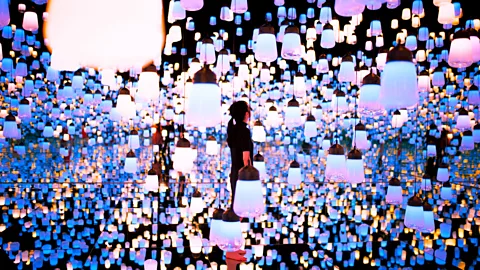 Mori Building Digital Art Museum/teamLab Borderless, 2018, Odaiba, Tokyo
Mori Building Digital Art Museum/teamLab Borderless, 2018, Odaiba, TokyoA new, interactive, digital-only museum aims to create a new relationship between people and art.
“The museum itself is one artwork,” Takashi Kudo of teamLab tells BBC Culture. The Mori Building Digital Art Museum: teamLab Borderless is a 10,000 sq m (107,639 sq ft) digital art space in Tokyo, Japan, where everything is controlled by computers, right down to the electronic tickets. The museum is made up of 60 individual artworks, but as the name, Borderless, suggests, the place is meant to be experienced as a whole, rather than as a series of individual pieces.
More like this:
But Borderless doesn’t just refer to the artworks. Kudo explains that teamLab, the creative collective behind the space, is looking for “a new relationship between humans and the world, including artworks, or other people”. The pieces in their museum blur the lines between art and viewer, by putting the visitors inside the art.
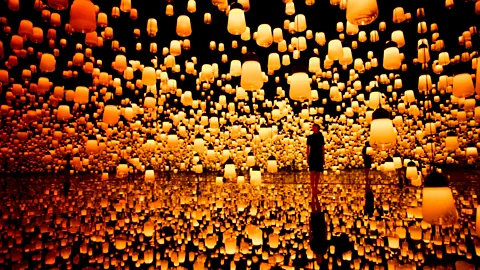 Mori Building Digital Art Museum/teamLab Borderless, 2018, Odaiba, Tokyo
Mori Building Digital Art Museum/teamLab Borderless, 2018, Odaiba, TokyoMade up of 520 computers and 470 projectors, the museum is inspired by the concept of interactivity and the art responds to movement as visitors walk through the space. In this piece, Forest of Lamps, the lights react to a person’s presence. If there is more than one person in the room, the lights will change based on both of their movements, and the process continues the more people you add. Kudo explains that having multiple people experiencing an artwork at one time, and becoming a part of it, means the experience is enhanced for all.
He expands this idea using the example of a visit to the Louvre Museum in Paris to see the Mona Lisa. When you look at the famous portrait and ponder her smile, he says, the experience is one to one, and the presence of others “can sometimes annoy us”. In contrast, teamLab Borderless seeks to show that the experience of their art is improved when you are surrounded by others, with each individual becoming a part of a collective piece of art.
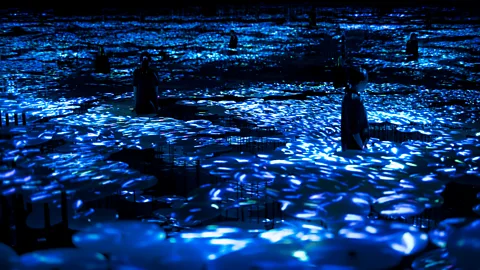 Mori Building Digital Art Museum/teamLab Borderless, 2018, Odaiba, Tokyo
Mori Building Digital Art Museum/teamLab Borderless, 2018, Odaiba, TokyoIn this room, visitors are surrounded by lily pads at varying heights, with computer-generated fish swimming around them. The artwork is run by a computer program, meaning that every experience of it is unique. “When we create something in the physical world, you need to use materials, for example using a canvas and painting on it, or using iron and making sculptures”, Kudo says. By using digital tools to create art, they are not constrained as traditional artists are.
 Mori Building Digital Art Museum/teamLab Borderless, 2018, Odaiba, Tokyo
Mori Building Digital Art Museum/teamLab Borderless, 2018, Odaiba, TokyoIn this room the artwork is controlled by the visitor’s smartphone. Each individual can create their own patterns in the light, and therefore are not only within the art, but helping to create the art around them. Kudo explains that teamLab want to “bring the people physically inside a digital world”.
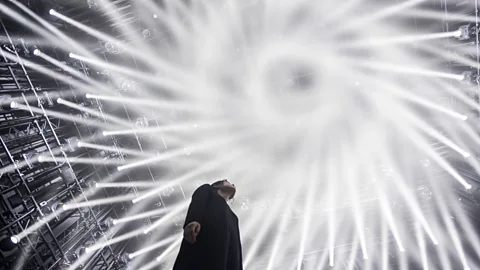 Mori Building Digital Art Museum/teamLab Borderless, 2018, Odaiba, Tokyo
Mori Building Digital Art Museum/teamLab Borderless, 2018, Odaiba, TokyoAn art collective that began in 2001, teamLab now has over 500 , including animators, programmers, architects, mathematicians and designers. The collective started work on this project “around two or three years ago”, says Kudo. Converting the space from a former amusement arcade took eight months, with a further four or five months to install the artworks.
Their artistic process is trial and error. A group sits in a room together, coming up with concepts and trying them out. Each speciality then tries to solve the problems that arise in their areas of expertise, and the idea evolves from there. There is no hierarchy in the organisation, and much like a joke, Kudo says, if you need to explain it, it’s dead.
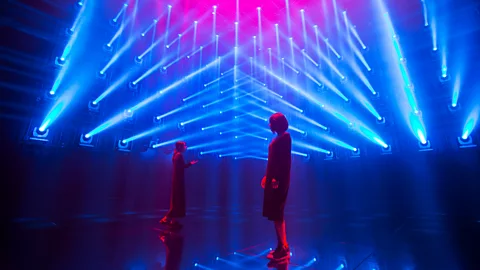 Mori Building Digital Art Museum/teamLab Borderless, 2018, Odaiba, Tokyo
Mori Building Digital Art Museum/teamLab Borderless, 2018, Odaiba, TokyoDigital art is inherently complicated, Kudo says, and requires a good deal of manpower behind the scenes to make it work. He uses the development of fine art to illustrate this point. People couldn’t paint outside because paint would dry too quickly, until someone invented the tube to put the paint in, keeping it fresh. With digital art, Kudo explains, “we have to create the brush, and we have to create the tubes, and we have to create the easels by ourselves.”
teamLab has a positive view of humanity and the future. One day, Kudo says, the collective aspires to create a city made entirely of digital art. He reasons that if people could live inside digital art, then they could be more positive towards each other. “Your existence itself becomes one part of the beauty, and if you felt beautiful as part of our artwork, maybe you can feel that beautiful to other people too”.
If you would like to comment on this story or anything else you have seen on BBC Culture, head over to our Facebook page or message us on Twitter.
And if you liked this story, sign up for the weekly bbc.com features newsletter, called “If You Only Read 6 Things This Week”. A handpicked selection of stories from BBC Future, Earth, Culture, Capital and Travel, delivered to your inbox every Friday.
